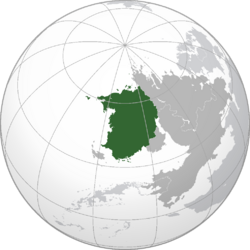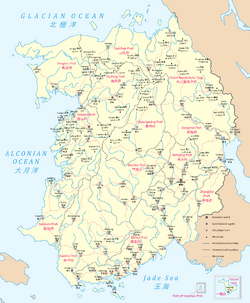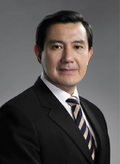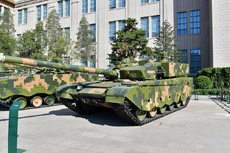Yingok: Difference between revisions
Philimania (talk | contribs) m (→Subdivisions) |
Philimania (talk | contribs) No edit summary |
||
| Line 101: | Line 101: | ||
== History == | == History == | ||
=== Prehistory === | |||
Yingok is hone to one of the world's oldest civilisation. Early hominids have inhabited the region as early as 1.05 million years ago, with the fossils of the [[Yunjou Man]], a ''{{wp|Homo erectus}}'' dating back to this period. The {{wp|fossilised}} remains of early ''{{wp|Homo sapiens}}'' of the [[Proto-Longic A]] culture dated roughly 50,000 years ago were also discovered in the [[Munlok]] region, along with stone tools and evidence of early settlements. [[Paleolithic Yingok|Paleolithic]] sites are also known to exist, most notably the [[Daisek]] cave paintings in [[Dongzhong]] (15,000 BCE), the [[Shuitou]] pillars near [[Honliun]] (13,000 BCE), and the [[Cingtongfa Rock Art]] in [[Cingtongfa]] (9,000 BCE). | |||
The first evidence of {{wp|pottery}} in Yingok dates back to around 7,000 BCE. This coincided with the rise of water levels, separating Yingok with !Japan as well as providing fertile land for early {{wp|agriculture|agricultural practices}} brought about by the end of the X Ice Age. The [[Neolithic Yingok|Neolithic]] in Yingok witnessed the emergence of settled farming communities, marking a significant shift in human development in the region. Yinese {{wp|proto-writing}}, characterised by intricate symbols and pictograms, began to emerge during the Neolithic Age. They have existed in [[Tongmun]] near [[Yuthung]] since approximately 5,200 BCE, marking the beginning of the [[Proto-Longic B]] culture. | |||
Proto-Longic B marked a crucial phase in the region's development. This period witnessed the further advancement of settled farming communities and the emergence of [[Proto-Longic B script]], a significant development in Yinese proto-writing around 4,000 BCE. The society during the Proto-Longic B period was organized into small-scale {{wp|chiefdom}}s, where local leaders held authority over their communities. These chiefdoms engaged in trade and exchange, allowing large networks of activity between the different regions of Yingok. Excavations at various sites dating back to this period have unearthed remnants of dwellings, tools, and artefacts, shedding light on their subsistence practices, craftsmanship, and social structures, most notably the [[Gongyun ruins]] near [[Sheunglong]]. The transition from {{wp|hunter-gatherer}} societies to settled agricultural communities brought about significant changes in their way of life. The first evidence of silk production also dated back to this period (3538 BCE) and was written in the historical records of the ancient settlement of [[Kunsaan]] near [[Qinfa]]. | |||
=== Zhong and An Dynasty === | |||
''TBA'' | ''TBA'' | ||
=== TBD === | |||
== Geography == | == Geography == | ||
Revision as of 17:02, 14 February 2024
This article is incomplete because it is pending further input from participants, or it is a work-in-progress by one author. Please comment on this article's talk page to share your input, comments and questions. Note: To contribute to this article, you may need to seek help from the author(s) of this page. |
Fourth Republic of Yingok 燕國 (Yinese) Yingwok | |
|---|---|
 Location of Yingok (green) in Abaria (dark grey) | |
 Subdivisional map of Yingok | |
| Capital | Dongsing |
| Largest city | Hoyzhau |
| Official languages | Yinese |
| Recognised regional languages | Shanese |
| Ethnic groups (2022) | 83% Yinese 14% Shanese 3% Others |
| Religion (2022) | 73% Sendou 21% Irreligion 6% Others |
| Demonym(s) | Yinese |
| Government | Unitary presidential constitutional republic |
| Yeung Kapkaa | |
| Dong Dak | |
| Nam Gat | |
| Wu Suk-fan | |
| Legislature | National Diet |
| History | |
| c. 3000 BCE | |
| 12-23 June 1892 | |
| 7 March 1966-23 November 1981 | |
| 19 April 1974 | |
| 29 December 1985 | |
| Area | |
• Total | 8,037,614 km2 (3,103,340 sq mi) |
• Water (%) | 0.004 |
| Population | |
• 2022 estimate | |
• Density | 81.17/km2 (210.2/sq mi) |
| GDP (PPP) | 2022 estimate |
• Total | |
• Per capita | |
| GDP (nominal) | 2022 estimate |
• Total | |
• Per capita | |
| Gini (2022) | medium |
| HDI (2022) | very high |
| Currency | Tungbei (銅幣/₣, TBI) |
| Time zone | TBA |
| Date format | dd-mm-yyyy |
| Driving side | right |
| Calling code | X |
| Internet TLD | .yn |
Yingok (Yinese: 燕國; Yingwok), officially the Fourth Republic of Yingok is the second largest country in Abaria. With an estimated population of over 600 million, Yingok is bordered by Razan, X, and X to the east, the Alconian Ocean to the west, and the Jade Sea to the South. Its 13 prefectures and 1 autonomous region spans a combined area of roughly 8,037,614 km2 (3,103,340 sq mi). Yingok is a unitary presidential constitutional republic with its capital in Dongsing, the largest city in Yingok by population. The largest city in the country by area is Hoyzhau which also serves as Yingok's main economic and commercial centre. Other major urban areas include Gongbuk, Samlong, Sei'on, Hasaan, and Yunzhau.
Yingok was initially inhabited by the Zhong Dynasty, followed by the An Dynasty, which brought significant cultural and technological advancements. However, the An Dynasty eventually fractured, leading to a fragmented political landscape and the rise of the Chiu Dynasty, which brought political stability and a cultural renaissance. The region experienced invasions from the !Vietnamese and the !Mongol Empire, leading to periods of conflict and disruption. The 15th century marked the beginning of the Third Winter Period, characterised by intense competition among various factions. This era eventually gave way to the Three Kingdoms Period, with the Hon Dynasty, Jeong Dynasty, and emerging Dong Kingdom vying for dominance over Yingok. The Saan Dynasty emerged victorious and established relative stability and economic growth in the region. However, the appearance of Calesian colonialism introduced new tensions and conflicts as the Saan Dynasty sought to protect its sovereignty.
In the 19th century, Yingok embraced the Industrial Revolution, leading to rapid urbanization and socio-political changes. The Saan Dynasty's response to demands for reforms varied, leading to political unrest. The dynasty was overthrown in 1892, and Yingok went through a series of political upheavals, including various dictatorships and revolutions. Yingok remained neutral during the Great War due to internal conflicts. In 1966, a civil war erupted between different factions, culminating in a nationalist victory and the establishment of the Fourth Republic. Throughout its history, Yingok has maintained complex relationships with its neighbours, pursuing diplomacy and economic cooperation. It seeks regional stability, trade, cultural exchanges, and peaceful conflict resolution. Present-day Yingok has implemented political reforms, aiming for a more democratic and inclusive society, although challenges remain in fully implementing political freedoms and civil rights.
Yingok retains its centuries-long status as a global centre of art, science and philosophy. It is the world's leading tourist destination, receiving over 73 million foreign visitors in 2020. Yingok is a developed country with the world's X-largest economy by nominal GDP and X-largest by PPP; in terms of household net income, it ranks X in the world. Yingok performs well in international rankings of health care, life expectancy and human development. It remains a great power in regional affairs, being leading member of numerous international organisations including the United Congress, X, and the Abarian Regional Forum.
Etymology
TBA
History
Prehistory
Yingok is hone to one of the world's oldest civilisation. Early hominids have inhabited the region as early as 1.05 million years ago, with the fossils of the Yunjou Man, a Homo erectus dating back to this period. The fossilised remains of early Homo sapiens of the Proto-Longic A culture dated roughly 50,000 years ago were also discovered in the Munlok region, along with stone tools and evidence of early settlements. Paleolithic sites are also known to exist, most notably the Daisek cave paintings in Dongzhong (15,000 BCE), the Shuitou pillars near Honliun (13,000 BCE), and the Cingtongfa Rock Art in Cingtongfa (9,000 BCE).
The first evidence of pottery in Yingok dates back to around 7,000 BCE. This coincided with the rise of water levels, separating Yingok with !Japan as well as providing fertile land for early agricultural practices brought about by the end of the X Ice Age. The Neolithic in Yingok witnessed the emergence of settled farming communities, marking a significant shift in human development in the region. Yinese proto-writing, characterised by intricate symbols and pictograms, began to emerge during the Neolithic Age. They have existed in Tongmun near Yuthung since approximately 5,200 BCE, marking the beginning of the Proto-Longic B culture. Proto-Longic B marked a crucial phase in the region's development. This period witnessed the further advancement of settled farming communities and the emergence of Proto-Longic B script, a significant development in Yinese proto-writing around 4,000 BCE. The society during the Proto-Longic B period was organized into small-scale chiefdoms, where local leaders held authority over their communities. These chiefdoms engaged in trade and exchange, allowing large networks of activity between the different regions of Yingok. Excavations at various sites dating back to this period have unearthed remnants of dwellings, tools, and artefacts, shedding light on their subsistence practices, craftsmanship, and social structures, most notably the Gongyun ruins near Sheunglong. The transition from hunter-gatherer societies to settled agricultural communities brought about significant changes in their way of life. The first evidence of silk production also dated back to this period (3538 BCE) and was written in the historical records of the ancient settlement of Kunsaan near Qinfa.
Zhong and An Dynasty
TBA
TBD
Geography
TBA
Government and politics
Yingok is classified as a unitary presidential constitutional republic, with the president acting as head of state and head of government as well as commander-in-chief of the Yinese Armed Forces. The president and vice president are elected by direct election for six-year terms, with a limit of three consecutive terms. The president appoints and presides over the cabinet, subject to the approval of the Appointments Committee. The vice president is the first in line for succession if the president resigns, is removed after impeachment, is permanently incapacitated, or dies. The vice president is usually, though not always, a member of the president's cabinet and may be appointed without the approval of the Appointments Committee. If there is a vacancy in the position of vice president, the president will appoint any member of the National Diet (usually a party member) as the new vice president. The appointment must then be validated by a three-fourths vote of the National Diet. The incumbent president and vice president are Yeung Kapkaa and Dong Dak, elected in 2021
Legislative power is vested in the unicameral National Diet, with its 92 members elected for 4-year terms. Each subdivision are allowed three representatives which are elected via direct vote in their respective subdivisions, while the remaining 50 members of the National Diet are elected proportionally based on the total national vote. The National Diet is headed by the Chancellor, currently Nam Gat, who is elected from among its members by a majority vote for 4-year terms. The Chancellor serves as the presiding officer of the National Diet and is responsible for facilitating legislative proceedings, and maintaining order within the National Diet.
The judicial branch is headed by the Supreme Court of Yingok, which serves as the highest court in the country. It is led by the Chief Justice, currently Wu Suk-fan, and comprises of 6 associate justices. The justices are appointed by the president on the recommendation of the Judicial Committee. Each subdivision has its own court system, which handles cases within their respective jurisdictions.
Since the Fung administration, corruption has been a key focus of reform in Yingok. The government has initiated various measures to combat and address corrupt practices within the country, including a lengthy anti-corruption campaign that has led to significant changes in the political and social landscape. The Anti-Corruption and Ethics Committee (ACEC) was also established as well during the Fung administration as an independent agency with the primary goal of investigating and prosecuting cases of corruption at all levels of government.
Allegations of corruption
TBA
Law
TBA
Subdivisions
Yingok is divided into 13 prefectures and 1 autonomous region. The prefectures are further subdivided into 394 counties and 23 municipalities. The Outer Razan autonomous region holds a higher degree of autonomy in local governance and decision-making.
Each prefecture is overseen by a local assembly and is headed by a prefectural governor who is elected by the population of the respective prefecture for a term of 5 years, with a limit of three consecutive terms. the local assemblies are comprised of representatives from the counties and municipalities within each prefecture. These representatives are elected by the county or municipal population for 4 year terms. While each local assembly operates independently from the National Diet, they are ultimately accountable to the central government and must abide by national laws and policies
| Flag | Name | Capital | Population |
|---|---|---|---|
| Namging | Dongsing | X | |
| Outer Razan | Altayara | X | |
| Seisaan | Yunzhau | X | |
| Dongmei | Hoyzhau | X | |
| Sikhoy | Samlong | X | |
| Fungwu | Wunsing | X | |
| Zhongdei | Bikhoy | X | |
| Sankwai | Sei'on | X | |
| Yauhing | Cinglong | X | |
| Munlok | Wongzen | X | |
| Cheungming | Qinfa | X | |
| Namho | Gongbuk | X | |
| Yatpui | Yukgong | X | |
| Saanbak | Fumun | X |
Foreign relations
TBA
Military
The Yinese Defence Force (YDF) serves as the armed forces of Yingok, playing a pivotal role in safeguarding the nation's security, protecting its sovereignty, and contributing to regional stability. It is comprised of several branches, including the Yinese Army (YA), Yinese Navy (YN), Yinese Air Force (YAF), and the Yinese Space Force (YSF). In 2022, Yingok military expenditure was $382.4 billion, or 3.9% of the Yinese GDP. Leadership of the YDF is vested in the Bureau of Defence, with the President of Yingok acting as commander-in-chief. With a total personnel count of 1.37 million, the YDF is considered one of the largest military forces in the world behind X.
27 military research laboratories are considered to be components of the Yinese Armed Forces, under the authority of the Bureau of Defence. These laboratories play a critical role in advancing the YDF's technological capabilities, supporting research and development efforts to enhance the military's readiness and effectiveness. In terms of intelligence, the military branch is led by the Military Intelligence Division (MID) and serves under the Bureau of Defence, while the civilian branch is led by the National Intelligence Office (NIO) under the Yinese National Police Force. Yingok's cybersecurity capabilities are regularly ranked as some of the most robust of any nation in the world.
In 2021, national conscription was abolished by the National Diet.
Economy
TBA
Demographics
TBA
Culture
TBA




